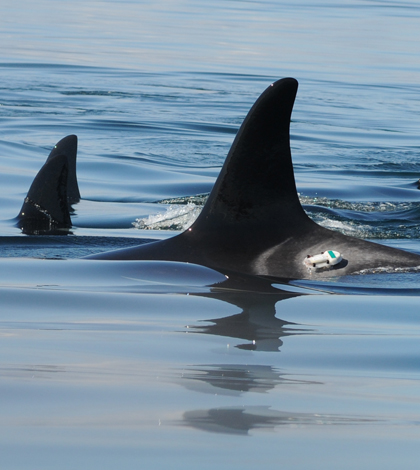For Noise Affecting Orcas, Vessel Speed Biggest Factor

Digital acoustic recording tags temporarily attached to killer whales measure vessel noise reaching the whales. Photos taken under NOAA Fisheries and Department of Fisheries and Oceans research permit (No.781-1824 and 16163). (Credit: National Oceanic and Atmospheric Administration)
Previous studies have shown that Southern Resident killer whales, also known as orcas, alter their behavior in the presence of vessels and the noise they give off, which affects their ability to communicate and find food. Research has also found that the whales likely expend extra energy to call more loudly when boats are operating nearby.
But a new study out of the University of Washington finds that the speed of the vessels near the endangered whale populations is more influential than the size of ships in how much noise ultimately reaches the whales.
The study, which was aided by researchers at the National Oceanic and Atmospheric Administration (NOAA), is the first to examine how much noise from individual boats reaches the orcas in the inland waters of Washington and British Columbia, where they are a popular attraction for recreational and commercial whale watching vessels.
The whale watching fleet has increased from fewer than 20 commercial boats in the 1980s to roughly 80 boats serving about 500,000 people a year, with an estimated $70 million value to the economy of Washington and British Columbia. In addition, the whales are frequently in the vicinity of ferries as well as private whale watching, fishing, and shipping vessels.
NOAA Fisheries has identified vessel traffic and noise as one of three main threats to recovery of the endangered population of resident killer whales, which now numbers about 80 animals, and has focused research on measuring and understanding the effect on the whales. These results and other studies will inform a NOAA Fisheries review of the effectiveness of vessel regulations over the coming year.
Thought it certainly seems from the outset that vessel size would be the more important factor in the levels of noise that the whales experience, researchers found that the assumption simply didn’t hold weight. Their goal was to find a missing link between what is seen at the surface (big, moving vessels) and what whales actually experience at the depths they inhabit.

Deborah Giles of the University of California, Davis tracks nearby vessel traffic with a laser positioning system she developed. (Credit: National Oceanic and Atmospheric Administration)
To get there, researchers temporarily attached digital acoustic recording tags, or DTAGs, to the whales with suction cups to track the amount of boat noise reaching the animals. The tags included hydrophones that recorded sounds for a few hours and then automatically detached from whales.
Meanwhile, scientists used a laser positioning system on a nearby research boat to track vessels within 1,000 meters, or more than a half-mile. This system recorded ship size, speed, location and vessel type.
The DTAGs and laser positioning system helped scientists overcome limitations of previous studies that looked only at noise in the whales’ environment or counted the number of boats instead of looking at detailed characteristics of each boat.
Combining the two technologies allowed scientists to get accurate data on the distance to the whale from each vessel in the area, meaning they could understand how each contributed to noise exposure.
Researchers then compared the characteristics of boats in the area with sounds recorded by the hydrophones to determine which factors most influenced noise reaching the whales. Results of that analysis revealed that the number of propellers and speed of the vessels affected the amount of noise reaching whales, with vessel speed playing the most important role.
Scientists say that limiting vessel speed in the vicinity of killer whales would reduce noise exposure of the population. But they note that noise is not the only factor determining how nearby vessels affect whales. The effects of noise also depend on what whales are doing underwater, such as how they use the sound, like in feeding, or if they’re interacting in certain ways affected by noise.
Federal regulations require vessels to stay at least 200 yards away from whales and at least 400 yards out of the path of whales. Regulations do not prescribe a speed limit but recommend that boats slow to less than seven knots within 400 yards of the nearest whale and avoid abrupt course changes. The main reason speed is not regulated is the difficulty in enforcing a speed limit and the previous lack of data indicating it was an important factor.
Full results of the study are published in PLOS ONE. The work was funded by NOAA and the University of Washington. Scientists from Cascadia Research Collective also assisted.
Top image: Digital acoustic recording tags temporarily attached to killer whales measure vessel noise reaching the whales. Photos taken under NOAA Fisheries and Department of Fisheries and Oceans research permit (No.781-1824 and 16163). (Credit: National Oceanic and Atmospheric Administration)





0 comments